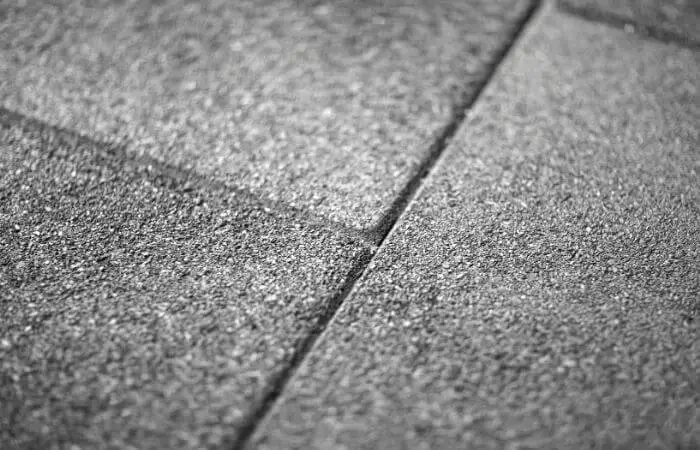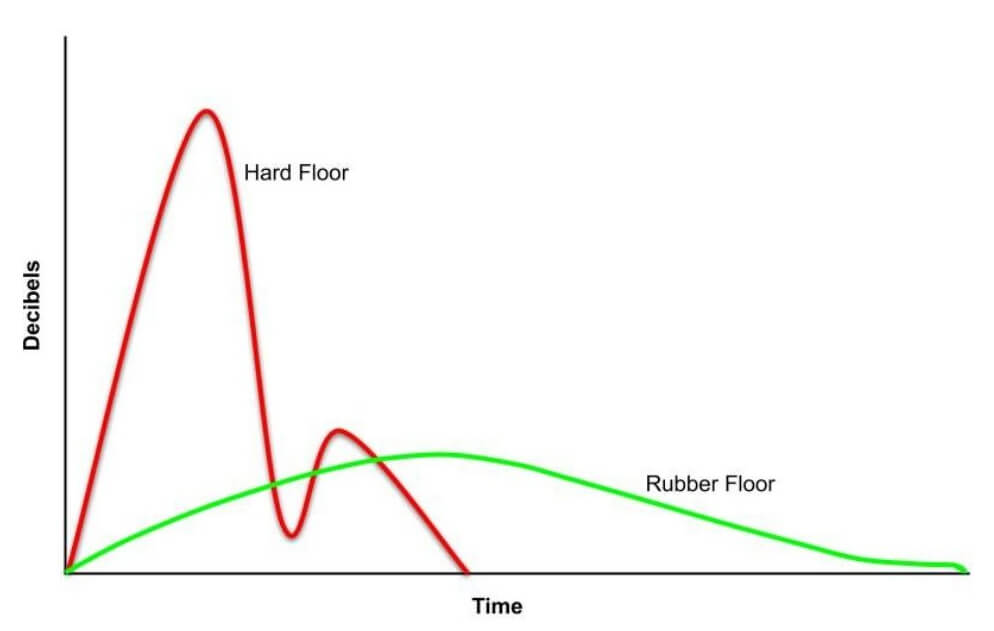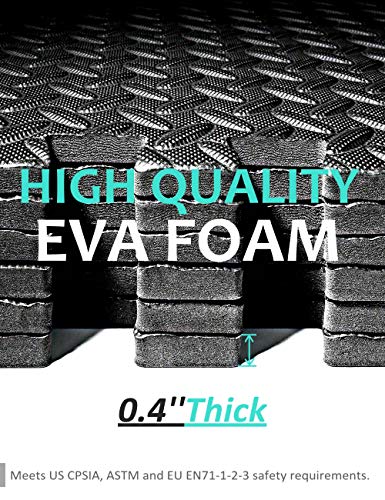Reducing gym noise is a must for gym owners.
One of the most effective ways of doing this is to use soundproof gym flooring.
If you’re looking for the most effective soundproof gym flooring we recommend:
What Is Soundproof Gym Flooring & How Does It Work?
the best soundproof flooring for gyms is made from high density, compression-molded rubber.

It usually comes in interlocking tiles which can be pieced together to cover an entire floor.
This type of material has the perfect structure for dampening sound vibrations.
Sound Waves & Gym Flooring
The loudest noises in a gym are caused by big impacts such as dropping weights, machine movement or other big impacts such as someone doing box jumps and landing heavily on the floor, or using a slam ball.
All of these create big vibrations that travel through the air as airborne sound and through the structure of the building through the floor and into the walls.
Reducing the intensity of an impact on the floor will greatly reduce the overall noise levels.
Soundproof gym flooring works by being slightly compressible, when a weight is dropped the weight doesn’t immediately stop moving as it would if you dropped it directly on a concrete floor, instead the flooring gives thus more gradually slowing the falling speed of the weight.

So instead of creating a high impact sound over a short duration rubber flooring increases the duration of the sound meaning that noises are much quieter as the energy is dispersed over a longer time frame into the floor.
Types Of Soundproof Gym Flooring
When it comes to soundproofing a gym floor choosing the right type of flooring is key.
Below are three different flooring types which will help with soundproofing to different degrees:
1. Rubber Mats
Rubber mats are extremely dense making them brilliant at deadening impact sounds.
Ice rinks routinely use rubber mats around the rink and they last for years despite having thousands of people walking all over them every week with blades on their feet.
So it goes wthout saying that they are also extremely durable.
This makes them perfect for heavy traffic areas of gyms as well as areas where weights are likely to be dropped on them.
Bear in mind if people practice overhead lifts and Olympic lifts in your gym it is a good idea to use weightlifting drop pads and quiet bumper plates to deaden the sound, as even the thickest soundproof gym flooring won’t deaden the sound of a heavy barbell being dropped from 7ft in the air!
Pricing
Rubber mat flooring is one of the more expensive forms of gym flooring.
Depending on where you get it from and its thickness it can cost between $40 – $100 per square meter.
In many cases it is well worth it as thick rubber mats last for decades.
Other flooring types often have to be replaced 5 or 6 times before a rubber mat needs replacing so in the long run they are more affordable.
How Good Are They At Soundproofing?
Thick rubber mats are very good at soundproofing providing they are thck enough and are installed correctly.
Ideally mats should be at least 1″ thick.
Their soundproofing impact will be greatly increased if you install a thick underlay beneath the rubber this creates an additional dampening barrier between the rubber and the floor surface minimizing vibration transfer into the floor.
Many rubber mats use designs on their underside which trap air thereby making them even better at soundproofing.
Best for:
- Busy commercial gyms
- Heavily trafficked areas of gyms
- Areas where weights are likely to be dropped
2. Rubber Rolls
Rubber rolls are a more affordable way of protecting large floors than using thick rubber tiles.
They offer less floor protection and soundproofing than rubber tiles because the rubber is significantly thinner.
Pricing
Varying from $3 to $15 per square meter rubber rolls are an affordable gym flooring solution for large areas.
How Good Are They At Soundproofing?
On their own rubber roll mats are not great at soundproofing, they lack the density to really have a significant impact on deadening noise.
However there are a few things you can do to improve their effectiveness:
- Lay thick underlay or carpet beneath them.
- Ensure you get a roll that has ribbing and lay the ribbing face down, this will trap some air which will help dampen sound.
Best For:
- Covering large areas
- Accompanying thick underlay
- People looking for hard-wearing budget-friendly options
3. EVA Foam Mats
EVA foam is a very versatile material that is used to make training shoe insoles, swimming floats, flip flops and of course gym mats.
This is the type of material that is often used to produce soundproof exercise mats.
It is very lightweight due to the fact that it contains thousands of tiny air pockets, this helps give it its buoyancy making it the perfect material for swimming aids.
It is a low-cost product and is commonly used in childrens play areas as well as gyms.
It is not particularly hard-wearing though and is prone to breaking up with heavy use.
It is certainly not advisable to use it in areas where weights are likely to be dropped on it.
Pricing
EVA foam is one of the cheapest options for gym flooring.
Prices typically range from $8-$25 per square meter.
How Good Are They At Soundproofing?
Due to the air it traps EVA Foam is generally a good soundproofing product.
However, most EVA foam mats are not best suited to busy areas in gyms due to their lack of density and thickness.
EVA is not suitable for making thick floor tiles from because it is too soft if EVA tiles are too thick they will be unstable and dangerous to walk on.
This means that they are usually quite thin, around 0.4″, so make next to no difference if someone drops a weight on them.
They can make a big difference in terms of gym acoustics as they reduce echo and make the gym sound quieter inside.
They will also dampen footfall noise and prevent it from transferring through the floor.
Best For:
- Low traffic areas
- Bodyweight workouts
- Budget buy
As an Amazon Associate I may earn a small fee from qualifying purchases at no extra cost to you. This helps us run the site, so thanks for your support!




